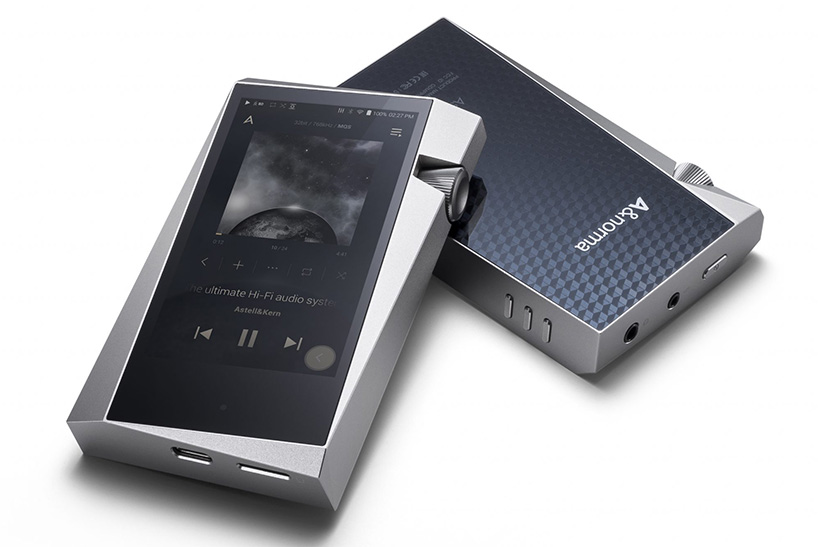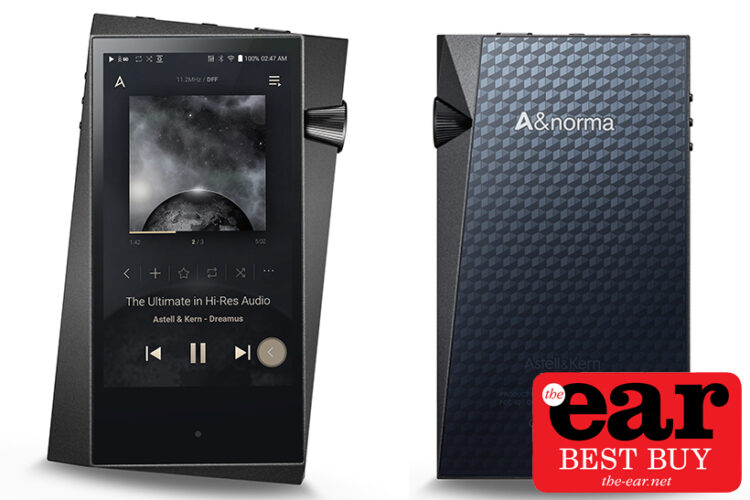The A&norma SR25 is the latest addition to Astell&Kern’s entry-level, portable, hi-res DAPs aimed at a those seeking an affordable improvement in sound quality over their smartphones without sacrificing user experience and connectivity. The AK70 and SR15 models the Korean company released in 2016 and 2019 demonstrated that even its most affordable offerings have a build quality that belies the price, and the SR25 is no exception.
An upgrade to the SR15 the £649 A&norma SR25 retains the striking and somewhat Star Trek-ish, five-axis, precision-milled aluminium body of its smaller brother with slanted touchscreen and holographic-patterned glass back. Despite being slightly bulkier, it still fits in the palm comfortably and remains compact and light enough to slip into a small pocket, even with a case on.
Aesthetics aside, the display is apparently slanted to improve ergonomics and promotes a more natural hold. The SR25’s 3.6-inch LCD screen with 720×1080 resolution does album cover art more justice than the SR15’s 3.3-inch 480×800 display and also makes navigation a little easier, though it’s still not quite as klutz-proof as the comparatively huge displays on modern smartphones.
After acclimatising to the quirky design, my eyes and fingers were instinctively drawn to the knurled dial that controls output level. Cleverly countersunk to guard against knocks, it looks like a giant winder from a precision timepiece and turns flawlessly with the roll of a thumb. The SR25’s volume spans 0 to 150 in 0.5 dB increments, an exceptionally fine level of adjustment that smartphone users can only dream of (an iPhone, for example, provides just 16 steps). This is especially useful for IEMs which often get too loud too soon on a typical volume control.

On the opposite side of the player is a trio of slender buttons that control playback. Although perfectly placed to operate with an index finger while holding the device, those with larger digits may struggle a little with the buttons’ close proximity to each other. Located on the bottom of the player is a USB-C port and microSD slot, the latter expands the player’s built-in 64GB storage by up to an 1TB. Not just for charging the battery and transferring music files, the USB-C interface also transforms the DAP into either a DAC or transport by allowing it to decode music from a computer or send digital audio to an external USB DAC. The SR25’s 3.7V Li-Polymer battery has a capacity of 3,150 mAh providing up to an epic 21 hours continuous playback – more than double the SR15’s 10 hours – charge time on a 5V 2A supply is a speedy 2.5 hours.
The two Cirrus Logic 43198 MasterClass DAC chips in dual-mono configuration are retained from the SR15 but have been tuned with new, ultra low-noise filters that apparently suppress hiss to inaudible levels, increasing dynamic range and low-level detail retrieval. A new, faster quad-core CPU and redesigned audio paths now provide native playback of DSD256 and 32-bit/384kHz PCM without conversion or downsampling for the purest fidelity and shorter buffering times. The player’s seamless handling of sampling rate changes is particularly impressive, I never once encountered a glitch or noticed a lag even when switching between hi-res PCM and DSD tracks.
Moreover, the Android 9.0-based operating system feels nice and responsive when navigating through menus and album cover art loads almost instantly. Copying music from my Macbook’s iTunes library to the DAP’s built-in memory was surprisingly easy. After installing the Android File Transfer app onto the laptop, it was simply a case of ‘dragging & dropping’ either individual files or complete folders. 2.4GHz WiFi enables users to download music streaming apps such as Deezer, Qobuz and Tidal via the Open APP platform, and ‘A&K Connect’ facilitates wireless playback of music stored on a computer or NAS that’s on the same WiFi network. There’s also a V-Link app to indulge your YouTube cravings if you don’t mind viewing on a small screen.

DAPs targeted at audiophiles often provide additional features you don’t get on smartphones. The SR25 is MQA-equipped and can therefore tap into the full sonic potential of both Tidal Masters and locally-stored MQA content. A plethora of file formats are supported as well as an almost equally long list of Bluetooth codecs including SBC, AAC, aptX, aptX HD, plus Sony’s latest ‘audiophile-friendly’ 990kbps LDAC. Kudos to A&K for their efforts in making Bluetooth streaming to high-end wireless headphones and speakers as good as it can presently be. There is also EQ, balance control, gapless playback, CD-ripping… the list goes on!
Like its little brother, the SR25 provides both single-ended and balanced analogue audio outputs, these are located at the top of the device. The single-ended output is a conventional three-pole 3.5mm TRS minijack while the balanced output is a four-pole 2.5mm TRRS, a connector that’s becoming ever more popular due to its compact size. For those with balanced headphones that terminate in 4.4mm TRRS, 4XLR or twin-XLR, aftermarket cables are available to convert to 2.5mm and are well worth the investment if you need to access all of this DAP’s output power or are a soundstage addict (more on this later).
The analogue outputs can not only be used to drive single-ended or balanced headphones but also an external preamp. Switch to Line Out mode and the DAP’s volume control is bypassed, you can then choose from four fixed output voltages to optimise the gain-matching with your chosen preamp, a very useful and often overlooked feature. (If you don’t have an amp with volume control or are using powered speakers, simply keep the DAP in headphone mode to benefit from its volume control). To those wondering if the two outputs can be used simultaneously the answer is no, attempting to do so results in both being muted.

The SR25 supplies healthy maximum output voltages of 2Vrms and 4Vrms and output impedances of 1.8Ω and 1.6Ω from its single-ended and balanced outs, respectively. These are the unloaded specs, the available voltages when driving headphones will depend on the current drawn. Output impedance is important when headphone impedance varies with frequency. With minimum load impedances of around 20Ω and higher the effect of the SR25’s output impedance is marginal, but with lower impedance designs such as balanced-armature IEMs the impact can be significant. An in-ear ‘phone like the Campfire Audio Andromeda, for example, has very low impedance across its lower frequencies compared to its upper frequencies and therefore sounds darker with low output impedance sources and brighter with high output impedance sources. An output impedance between 1.5Ω and 2Ω is considered by many to be the sweet-spot for the Campfires and should make the SR25 a great partner.
Sound quality
Beginning the audition with the familiarity of my over-ear headphones, the SR25 has ample drive for both high- and medium-sensitivity designs. Even on its lower-powered, 3.5mm single-ended output I reached comfortably loud SPLs with the likes of the Sennheiser HD600 and HD800S and Audio-Technica ATH-ADX5000 (all 104dB/1Vrms sensitivity) with the volume set around 120. With twice the available voltage, I hit the same SPLs on the 2.5mm balanced output with the volume twelve clicks lower.
Single-ended performance is excellent and bests my iPhone in several areas. The delivery is not only smoother and has more body and warmth, there is also an appreciable improvement in low-level detail. There is, however, still a slight fuzziness to the imaging and the soundstage remains relatively compact. The latter is more noticeable on an intimate-sounding headphone like the Sennheiser HD600, it isn’t such an issue with an angled-driver design like the HD800S that renders an inherently wide and spacious image.
The more powerful, balanced output expands the peripheries considerably and exchanges some of the single-ended’s richness and intimacy for more clarity, separation and ambience. This works especially well with the HD600 and I was genuinely taken aback by the transformation, making this classic Sennheiser sound effortlessly big and open is quite an achievement. It stretches the soundstage out and away from the listener’s ears and puts space around instruments better than any other DAP I’ve auditioned, even giving my desktop tube amps a run for their money. I see this greatly benefiting IEMs which, by design, are positioned much closer to the ear drum and are unable to harness reflections from the outer ear to convey spatial cues. I particularly enjoy the way string swells are presented; they emerge, radiate freely and recede with almost an ethereal, weightless quality. Whilst imaging is in sharper focus in all areas, there is an especially welcome firming up and clearer texturing of the low end.

If you’ve read my previous reviews you’ll have gathered I’m not really into in-ear monitors (I struggle to get a secure and comfortable fit), but since Astell&Kern kindly lent me a pair of their new T9iE to try, it would have been rude not to. The T9iE is the third collaboration between A&K and Beyerdynamic and has again been tuned especially for A&K DAPs. Using a single, dynamic driver with 16Ω nominal impedance, it is described as having a “neutral sound signature with soft treble, linear midrange and slightly elevated bass” and departs from the more V-shaped tuning of the T8iE. The T9iE’s cable is terminated with balanced 2.5mm TRRS, a 2.5mm-to-3.5mm adaptor is however included for use with single-ended sources.
I was unable to locate sensitivity specs for the T9iE but reached comfortably loud levels on the SR25’s balanced and single-ended outputs with the volume set around 75 and 85, respectively. In other words, there is an ocean of power on hand for IEMs. More importantly, I did not notice hiss on either output, this DAP’s background is a suitably dark abyss. An IEM’s presentation depends greatly on the design of its tip and how well it fits in the ear canal. The T9iE comes with both silicone and foam tips in various sizes and I found it easier to get a good seal with the foam. The silicone tips deliver a firmer and faster sound with a crisper top end, while the foam offer a smoother and more downward-sloping response with meatier mids and warmer bass. As with my over-ears, the SR25’s balanced output grips and contours the T9iE’s low frequencies more assertively and resolves a roomier image with more precise instrument placement. I was thoroughly impressed with this pairing, it strikes a compelling balance between detail and warmth and is incredibly immersive.
Verdict
With a larger screen, longer battery life, increased native sample rate support and lower noise floor, Astell&Kern’s new A&norma SR25 is an alluring upgrade over the SR15. For those able to take advantage of its more powerful balanced output, this DAP will drive just about any headphone from super-sensitive IEMs to big over-ears, and render a soundstage large enough to compete with serious desktop amps. It effectively wipes the floor with smartphone alternatives and I’d be surprised if any other portable audio players at this price could match it’s wide-open delivery.


